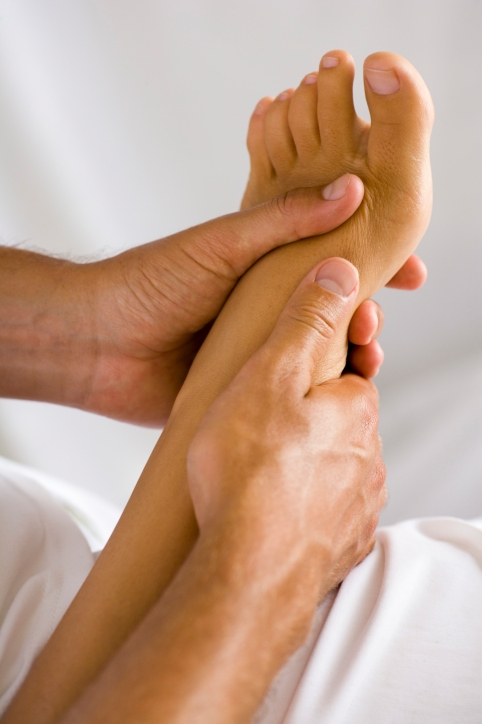
Foot Health Awareness
April 20, 2010
Diseases, disorders and disabilities of the foot affect the mobility and quality
of life of millions of Americans. In fact, more than 75 percent of Americans
will experience foot and ankle problems of varying degrees at some point during
their lives. Some of these foot problems are inherited, but many are a result of
a lifetime of accumulated abuse and neglect. Fortunately, many foot conditions
can be prevented or treated by wearing properly–fitting footwear or by seeking
early medical attention. According to a recent study by The American Podiatric
Medical Association (APMA), however, only about one–quarter of Americans who
have experienced a foot ailment have seen a physician of any kind about their
ailments, and only 12 percent have visited a podiatrist.

The Foot
The anatomy of the human foot is very complex. Each foot contains 26 bones, 33
joints and over 100 ligaments, tendons and muscles, along with a network of
blood vessels, nerves, skin and soft tissue. All of these combine to provide the
body with support, balance and mobility by helping to maintain the arch, by
absorbing stress and shock, and by providing a means to propel the body through
all types of activities.
Foot ailments
Achiness or foot pain can have many causes and should not be ignored or regarded
as a normal part of life. There are many things that can affect the health of a
person’s feet including his or her activity level, occupation, health conditions
and choice of footwear. The amount of time that an individual spends on his or
her feet can also take its toll. Twenty–four percent of Americans report
spending a full six hours or more on their feet during a typical day, while 20
percent regularly spend between four and six hours per day on their feet.
Additionally, an average day of walking exerts a force equal to several hundred
tons on the feet. Over time, this extensive use can cause problems.
According to the APMA, some of the most common ailments affecting the feet
include:
- Athlete’s foot: Athlete’s foot is a skin disease that is caused by
a fungus. It usually forms between the toes or on the bottom of the feet and can
then spread to other parts of the body. Signs of athlete’s foot include dry
scaly skin, itching, inflammation and blisters.
- Blisters: A blister is caused by skin friction. A blister should never be
popped as unbroken skin over a blister provides a natural barrier to bacteria
and decreases the risk of infection.
- Bunions: A bunion is a painful, bony bump that forms on the joint
at the base of the big toe. It can become enlarged, forcing the big toe to crowd
against the other toes. Bunions can develop for a number of reasons, but a
common cause is the wearing of shoes that are too narrow in the forefoot and
toe. Bunions can also develop as a result of an inherited structural defect,
stress on the foot or a medical condition such as arthritis.
- Corns and calluses: Corns and calluses are thick, hardened
layers of dead skin cells that develop to protect the skin after exposure to a
repetitive force such as friction between an individual’s foot and his or her
shoe (especially if there is an irregularity in the shoe). Corns ordinarily form
on the toes and calluses on the soles of the feet.
- Hammertoe: A hammertoe is a toe that bends upward in the middle
and then curls down in a hammer–like or claw–like shape. Although the condition
usually stems from muscle imbalance, it is often aggravated by ill–fitting shoes
or socks that cramp the toes.
- Heel pain: Heel pain is the most common foot problem that doctors
encounter. It can generally be attributed to faulty biomechanics which place
excess stress on the heel bone, ligaments or nerves in the area. Excess physical
activity, ill–fitting shoes and excess weight can result in pain and
inflammation in the heels, and general health conditions such as arthritis, gout
and circulatory problems can be additional causes.
- Heel spurs: A heel spur is a growth of bone that usually begins on
the front of the heel bone and points toward the arch of the foot. Heel spurs do
not always cause pain, but pain may result when inflammation develops at the
point where the spur forms. Both heel pain and heel spurs are often associated
with plantar fasciitis, a painful condition involving the inflammation of
the long band of connective tissue that runs from the heel to the ball of the
foot.
- Ingrown toenails: An ingrown toenail is a common condition in which the
corner or side of the toenail grows into the soft flesh of the toe. The result
is pain, redness, swelling and, sometimes, infection. Ingrown toenails are
frequently caused by improper nail trimming but are also caused by shoe
pressure, injury, fungus infection, heredity and poor foot structure.
- Morton’s neuromas: A noncancerous (benign) growth of nerve tissue that
most commonly develops between the third and fourth toes, Morton’s neuroma
causes a sharp, burning pain in the ball of the foot. Additionally, toes may
sting, burn or feel numb. Neuromas are caused by bones and other tissue
rubbing against and irritating the nerves. Abnormal bone structure or pressure
from ill–fitting shoes can also create the condition.
- Plantar warts: Plantar warts are noncancerous skin growths on the
soles of the feet that are caused by the human papillomavirus (HPV) which enters
the body through small cuts and infects the skin. Plantar warts often develop
beneath pressure points in the feet, such as the heels or balls of the feet.
Most warts are harmless and benign, though they can be painful and unsightly.
Warts often come from walking barefooted on dirty surfaces or littered ground.
It is important to note that self–treatment can often turn a minor problem into
a major one. When any of the above conditions occur or persist, an individual
should see a podiatrist. Podiatric physicians/surgeons are specifically and
extensively trained in the diagnosis and treatment of all diseases, disorders
and disabilities of the foot.
There are a number of serious medical conditions that are sometimes first
detected in the feet. Specifically:
Joint stiffness in the feet could mean arthritis. According to the
Arthritis Foundation, approximately 90 percent of the 1.3 million Americans with
rheumatoid arthritis will develop symptoms in the foot and ankle. For some
individuals, foot symptoms are the first indication of the presence of
rheumatoid arthritis. When the condition affects the feet, pain usually begins
in the toes and later spreads to the rest of the feet and ankles. The joint
damage caused by rheumatoid arthritis can eventually change the shape of the
toes and feet. Once diagnosed, it can often be treated effectively with
medications, exercise and, in some cases, surgery.
Gout is another type of arthritis that causes foot pain. It occurs when
deposits of uric acid accumulate and collect in the joints — particularly the
big toe — and cause intense, episodic pain. Gout can be treated with
non–steroidal anti–inflammatory drugs (NSAIDs) and other medications such as
steroids. Performing regular physical activity, drinking appropriate amounts of
water, avoiding certain medications and staying at a healthy weight can help
prevent gout attacks.
Tingling or numbness in the feet could be a sign of diabetes. Excess
sugar in the blood can lead to nerve damage, causing tingling, loss of sensation
and compromised blood circulation in the feet. Diabetes is a major cause of foot
problems in the United States and can lead to the surgical removal of a toe or
even more of the foot or lower leg. The American Diabetes Association estimates
that one–in–five people with diabetes who seek hospital care do so for foot
problems. By taking proper care of the feet, most serious health problems
associated with diabetes can be prevented. It is also important for diabetics to
quit smoking, wear supportive shoes and avoid being barefoot to prevent
unnecessary foot trauma.
Swelling of the feet might indicate kidney disease, heart disease or high
blood pressure. Persistent swelling of one or both feet may be due to
kidney, heart or circulatory problems. Increased or periodic swelling in the
feet and lower extremities may mean that high blood pressure has contributed to
heart disease. When the heart muscle walls weaken and are unable to pump as
strongly, the kidneys often respond by causing waste products and fluid to build
up in the body, causing swelling in the feet.
If a podiatrist detects any of the above conditions in a patient, he or she will
refer the individual to a primary care physician for evaluation, diagnosis and
treatment.
Healthy Feet
Healthy feet are an integral part of a healthy and happy lifestyle. The APMA
recommends the following to keep your feet healthy:
- Do not ignore foot pain — it is not normal. If pain persists, see a podiatric
physician.
- Inspect feet regularly. Pay attention to changes in their color and temperature.
Look for thick or discolored nails (a sign of developing fungus) and check for
cracks or cuts in the skin. Peeling or scaling on the soles of feet could
indicate athlete’s foot. Any growth on the foot is not considered to be normal.
- Wash feet regularly, especially between the toes, and be sure to dry them
completely.
- Trim toenails straight across, but not too short. Be careful not to cut nails in
corners or on the sides; it can lead to ingrown toenails. Persons with diabetes,
poor circulation or heart problems should not treat their own feet because they
are more prone to infection.
- Make sure that shoes fit properly. Purchase new shoes later in the day when feet
tend to be at their largest and replace worn out shoes as soon as possible.
- Select and wear the right shoe for the activity being engaged in (i.e., running
shoes for running).
- Alternate shoes — do not wear the same pair of shoes every day.
- Avoid walking barefooted — feet will be more prone to injury and infection. When
at the beach or wearing sandals, always use sun block.
- Be cautious when using home remedies for foot ailments.
- If you have diabetes, you should see a podiatric physician at least once a year
for a check–up.
Paying attention to proper foot health is vital to maintaining the body’s
overall wellness. Painful feet and other foot ailments can affect our ability to
enjoy the most basic activities in our daily lives. It is, therefore, very
important to treat our feet with respect and invest in their good health.
MEDICAL DISCLAIMER: The information is not intended to constitute medical advice
and is not a substitute for consultation with a physician or other healthcare
provider. Individuals with specific complaints should seek immediate
consultation from their personal physicians.